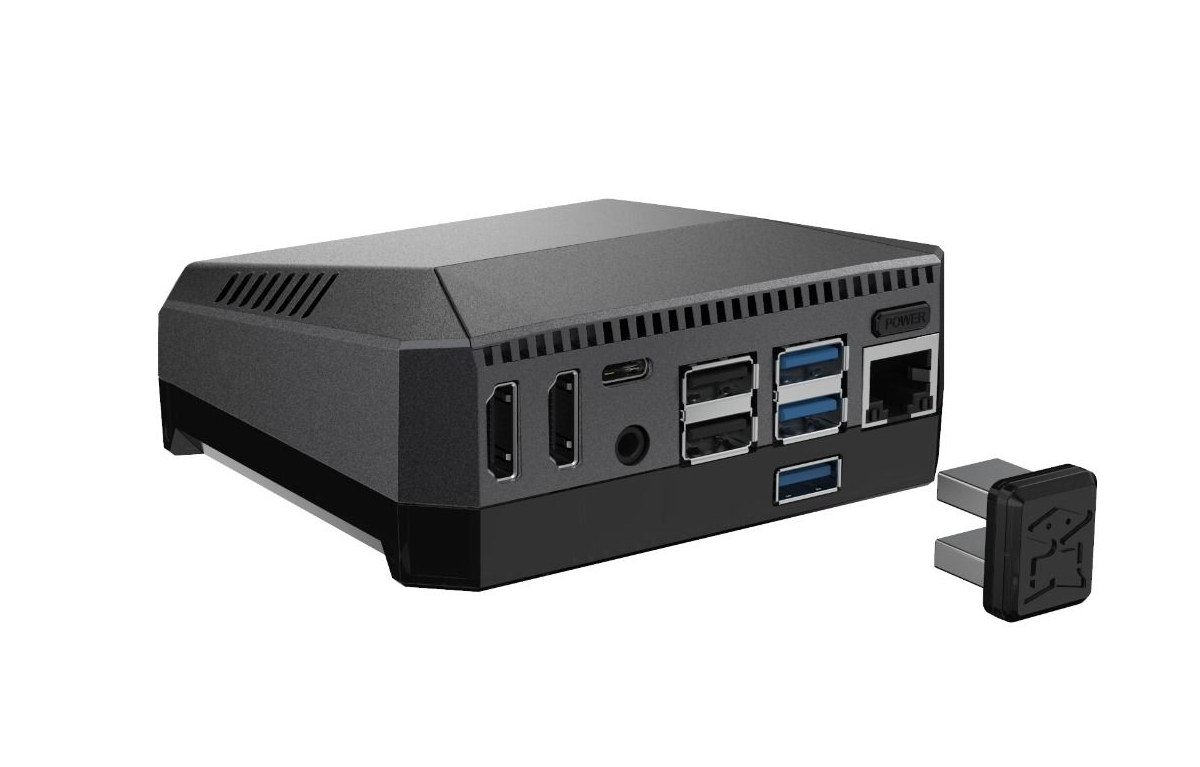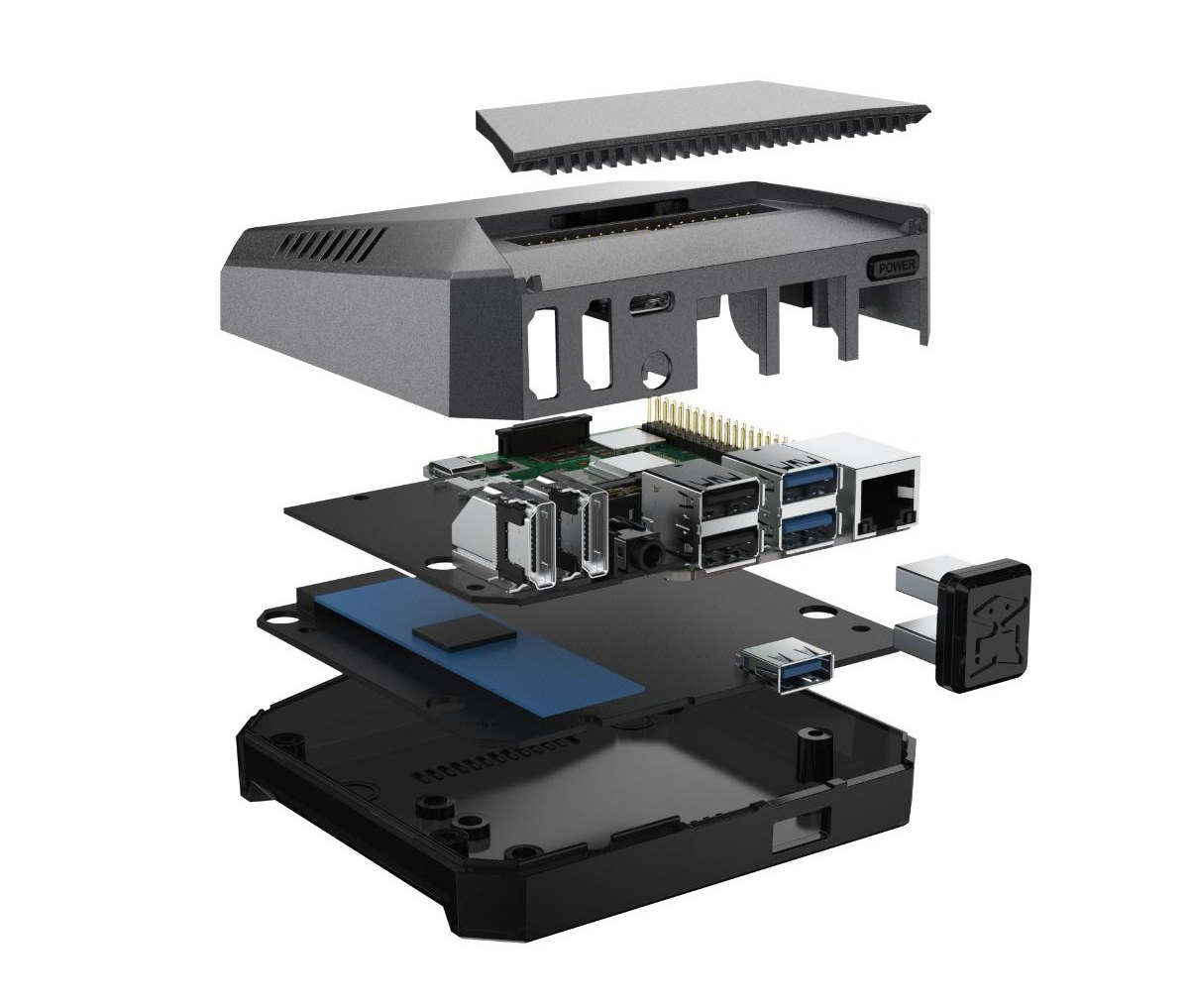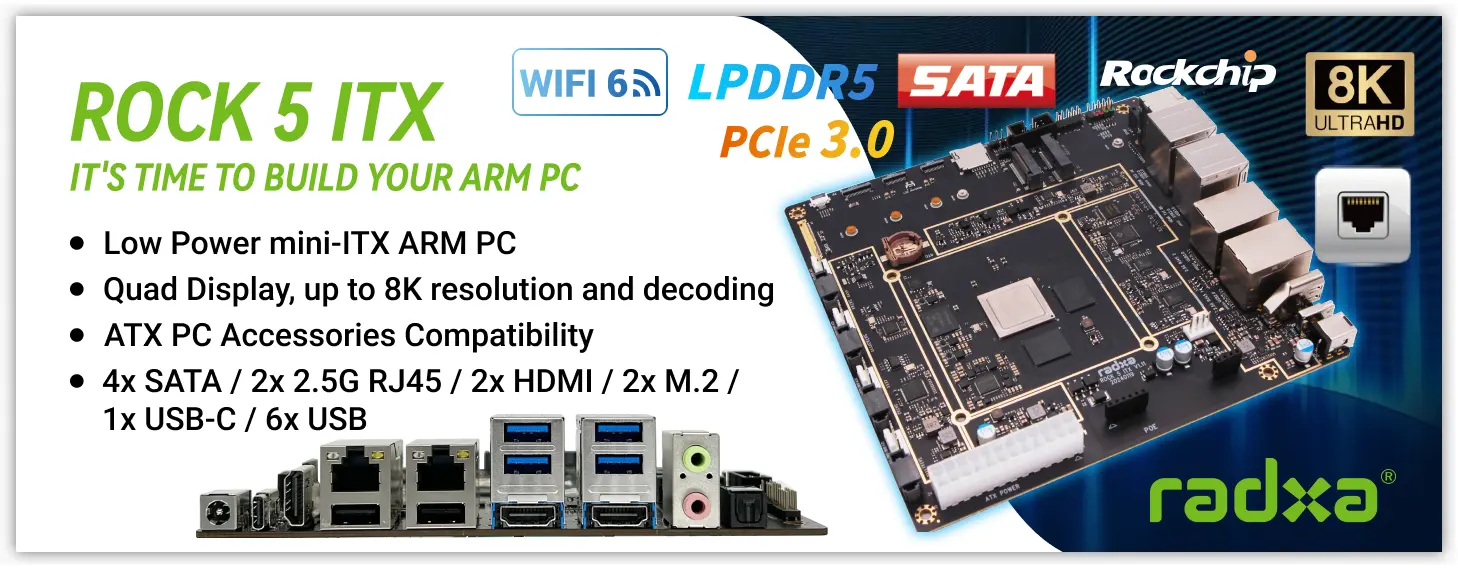Yesterday, we noted that DeskPi Pro Raspberry Pi 4 case offered an interesting alternative to Argon One enclosure thanks to support for 2.5-inch SATA SSD/HDD, full-sized HDMI ports, and a PWM fan.
What I did not know at the time was that Argon40 had worked on an improved version of their case with Argon One M.2 case also offering full-sized HDMI ports, support for M.2 SATA SSD storage, and a software-controlled fan.

- SBC – Compatible with Raspberry Pi 4
- Storage – M.2 SATA SSD with Key-B or Key-B & M with UASP support on Raspberry Pi 4; Enabled via an adapter with two USB 3.0 port as shown in the render above
- Video & Audio Output – 2x Full-Sized HDMI ports plus AV port
- Expansion – Access to 40-pin GPIO header externally as in the original case
- Misc – Built-in IR receiver compatible with Argon ONE Remote,
- Power Management
- USB-C port on the rear panel for power input
- Power button
- Configurable automatic booting after power loss aka “Always ON Mode”.
- Thermal Management
- Passive cooling using the aluminum alloy top case as a large heatsink connected to the CPU of the Raspberry Pi 4
- Active Cooling – Software programmable 30mm PWM fan
- Dimensions – 10.9 x 10.2 x 4 cm (estimated)

You can control power & fan settings by software by following instructions in the wiki. Compared to DeskPi Pro, Argon One M.2 case is more compact and costs a little less since it’s up for pre-order for $45 against $55 for the DeskPi Pro enclosure. However, the latter ships with a power supply, and you would have to consider the cost of using an M.2 SATA drive instead of a 2.5-inch SSD/HDD.
Thanks to Simon for the tip.

Jean-Luc started CNX Software in 2010 as a part-time endeavor, before quitting his job as a software engineering manager, and starting to write daily news, and reviews full time later in 2011.
Support CNX Software! Donate via cryptocurrencies, become a Patron on Patreon, or purchase goods on Amazon or Aliexpress





Unless I missed something, RPI4 has Bluetooth 5.0
RPi4 has Bluetooth 5.0 in name only. It’s the same Cypress CYW43455 wireless chip as RPi3 but with a firmware update. None of the good (and optional) BT 5.0 features are enabled. I blame Bluetooth SIG for making so many features optional.
That has nothing to do with this case though. The article is just restating what Pi4 has. Although the case will block some of the signal.
It’s hard to tell without further signal analysis whether the case will block the signal or actually amplify the signal in some directions.
I found a Bug in this website. before we could share the article using the Social Media Icon, like the Facebook, Twitter…, Now this option is gone! I tested this on Firefox 81, Opera & Google Chrome.
Screen capability?
Same as Raspberry Pi 4 which should be 2x 4K.
I don’t really understand the point of the M.2 adapter, if it’s sending the data over usb then wouldn’t it just be easier to get an external ssd and plug it into just one USB 3 port? The other case has a much better design since it houses its SSD internally instead of hanging off of the back of the case waiting to get snapped in half, unless I’m not understanding how that adapter actually works.
Both cases have the same design for the SSD. The storage device is installed internally (i.e. inside the case), and needs an adapter to connected one of the USB 3.0 “out” port from the Raspberry Pi to the USB 3.0 “in” port connected to the SSD board.
What ‘other case’ are you guys talking about. The M.2 is the only Argon case that I know of that houses an SSD internally.
On this blog the 1st sentence of each and every article contains useful information and is not just an intro that can be skipped.
I have always thought that the external jumper detracted from the whole thing. The most serious SSD case I have found is the NesPi4. Don’t get me wrong, I love my Argon One case, but I don’t like external jumpers even that much more.
The NesPi4 appears flawed as it uses an incompatible UASP controller chipset model from JMicron and needs ‘quirks’ added to the config to disable full UASP functionality otherwise you’ll most likely experience slowness issues. The devil is in the detail ?
I’d love to see the output of a ‘lsusb’ command so we could find out which manufacturer and chipset the USB 3.0 to SATA controller it’s using……
I certainly hope it’s using an ASMedia controller, something like an ASM1153E chipset, otherwise if it’s like JMicron it’ll need ‘quirks’ aded to the config and loose UASP functionality…..
Do you have any sources for this? I’m using JMS567 and JMS578 with UAS and without quirks since years.
That’s why I asked which chipset it’s using, look here at the issue with the Nespi4
https://amp.reddit.com/r/RetroPie/comments/i9f45b/retroflag_nespi_4_ssd_boot_slowness_and_workaround/
> look here at the issue with the Nespi4
This Nespi4 thing is obviously using an JMS562 (never came across that chip before).
As already said: ‘I’m using JMS567 and JMS578 with UAS and without quirks since years.’ And the same is true for ASM1153 with ASMedia’s original firmware (not those crippled ASM1153 with Seagate firmware).
Please be aware that situation with RPi Trading Ltd.’s kernel might be different: https://www.jeffgeerling.com/comment/11552#comment-11552
Of course it is different with the RPi4 that’s why I made the comment ??????
ASMedia ASM1153 works perfectly with RPi4 fully working UASP functionality and speed – I use it ?
Need the technical details on this enclosure to know either way ??
According to a reply from them on their Facebook page, they are using the great ASMedia ASM1153E controller chip so full UASP compatibility should be guaranteed whoop whoop ??
in your opinion, which one is the best in terms of quality price